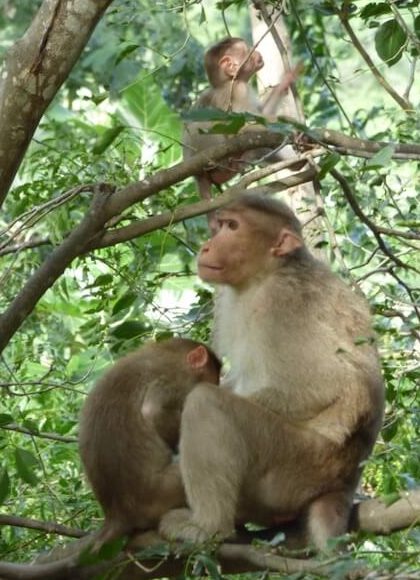India’s Micro-Rewilding Formula is Combating Habitat Destruction
The Indian example is an innovative alternative to Africa’s better known projects.
June 8, 2021

In 2015, I embarked on an experiment in rewilding. Along with a small group of like-minded friends, I bought 115 acres of denuded farmland at the edge of Tadoba, a national park in Western India. I wanted to discover what would happen if we just gave nature some room to bloom.
The decimation of the world’s wild spaces has been an ongoing catastrophe for decades.
Currently, only 15% of the earth’s land surface is formally protected from human encroachment by governments globally.
Why humans need the wilderness
But conservationists say this number needs to increase to at least 30% over the next decade. This is to ensure that humans can continue to derive the benefits they do from nature.
These are benefits that include the filtration of drinking water and the storage of carbon that would otherwise increase global warming.
Situation in India
In India, there are currently 870 notified protected areas. These are designated zones where human habitation is prohibited. Taken together they cover just over 5% of the country’s land mass.
Both at the government and individual level, a multi-pronged effort is urgently needed to bolster natural eco-systems.
The coming of age of rewilding
A key strategy in achieving this goal that has now come of age is rewilding. It is the process of restoring large scale areas to wilderness, as well as the corridors between them needed as migration pathways by animals.
These spaces further need to be replenished with the keystone species and apex predators that were once found there.
Individuals matter as much as governments
The advent of individuals, rather than governments, taking on the challenge of rewilding areas is fairly recent. There are several heartening instances, especially in Africa.
The wealthy American philanthropist Paul Tudor Jones, for example, leased 350,000 acres in Tanzania in 1993.
African successes
He stocked it with native wildlife, trained anti-poaching squads, brought in researchers and along with Luke Bales of South Africa, created the Singita Grumeti Game Reserve.
In Zimbabwe, the same team began creating the 130,000-acre Malilangwe Game reserve from 1994 onward. This blueprint is being replicated by several conservationists across the globe.
Not replicable in land-stressed countries
Although impressive, this model is not always replicable in countries that are land stressed, such as India. The acreage is far too expensive there for large scale private conservatories.
Vast tracts of land are impossible to come by. Various laws and regulations in India make it difficult for individual conservationists to legally procure land.
In order to protect indigenous communities, for example, it is prohibited for people classified as non-tribals to buy tribal land.
Winds of change
There are, however, a growing number of instances of smaller rewilding projects, such as Anil and Pam Malhotra’s 300-acre labor of love, the Sai Sanctuary.
This adjoins a 180 km square, semi-evergreen Brahmagiri forest in the southern state of Karnataka.
The Malhotras began by combining a coffee and cinnamon plantation, to which they gradually added small, neighboring parcels of land. Within a few years, their tract resembled a forest with walking trails. Wild creatures embraced it.
Nature just needs space
The thing about nature is that given space, she rewilds herself. Forests jump across fences with ease. They march straight into your living room, bearing fruit, flowers and seeds.
I was to discover this firsthand as my experiment in Tadoba unfolded.
The Tadoba experiment
The patchwork of land that my friends and I bought had over the generations become too fragmented for farming.
Ours was a weed-infested dust flat where the ground had been pounded hard by cattle hoofs, trapping the seeds beneath.
We named it Guldaar, after the poetic word for the rosetted leopard.
It was left unfenced and porous to the adjoining forest, the Tadoba-Andhari National Park. We added a couple of small water bodies. A basic hut was built for the locally employed guards whose main job was to keep cattle and timber thieves away.
Nature taking a stroll
At first, the grasses took hold, bringing insects and butterflies. Then came the low shrubs which made perfect hiding nooks for wild boar and other small creatures. Varieties of deer came to quench their thirst.
We added camera-traps to the water holes and well-used animal trails. Before long, nature strolled right in, as the winds, insects, birds and animals scattered a cavalcade of seeds all over.
A standing army of trees
Soon after the first monsoon, saplings of endemic trees like mahua and jamun formed a standing army. Within a short spell, their roots sank deep and the forest strengthened its foundations.
Dense clumps of bamboo shot up. The flame of the forest bloomed a vibrant orange. And there was enough mahua nectar to render a family of sloth bears merry and legless.
Governments taking note
Taking into account these successes, the governments of several states in India have begun declaring eco-sensitive zones. In these, the income from national parks is now going towards paying farmers to rewild the forest fringes.
Buffer zone safaris, between formally protected national park territory and habitable zones, are becoming popular.
Although large-scale rewilding projects remain a challenge in India, the hope is that many more people will replicate the micro-rewilding model. This would create a mosaic of green havens across the landscape for posterity.
Conclusion
Back on our patch of forest on the doorstep of the Tadoba forest, we can now watch chital deer and langur monkeys forage, setting off the nervous cackle of jungle fowl.
We awake to the satisfaction of camera-trap images of tigers, leopards, wild dogs, porcupines and civet cats that have come to trust the area as a safe haven.
Fittingly, a female guldaar, after whom our rewilded land is named, has just chosen it as her birthing ground and nursery.
Takeaways
Rewilding, or returning habitats to the wild, is a key strategy to ensure the earth remains sustainably habitable for humans in the future.
The best-known African model of rewilding is not replicable in land-stressed countries like India. The acreage is far too expensive there for large-scale private conservatories.
In India, a growing number of micro-rewilding projects are demonstrating a credible alternative to the African standard.
The thing about nature is that, given space, she rewilds herself. Forests jump across fences and can march straight into your living room bearing fruit, flowers and seeds.
The success of micro-rewilding projects is leading several state governments in India to pay farmers to rewild the forest fringes.

